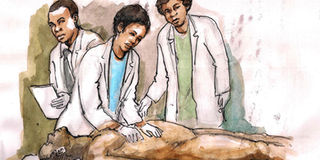Postmortem clears mysteries

Alot of information can be got from a postmortem.
What you need to know:
- To some people the postmortem examination is even baffling as the cause of death may apparently be obvious.
- The medical postmortem is also useful in cases of medical litigation especially in medical negligence.
- Postmortem examinations are important to establish fatal disease outbreaks.
Death is mysterious and anything to do with it is viewed with apprehension, not least of all the postmortem examination. Most people dread this examination performed on a relative and it is abhorred by some religions. The value of the examination is questioned by many as it may not be of any value to the deceased. What is sometimes even worrying to some relatives is that some parts (tissues) of the dead body are removed by the doctors, which parts the deceased is buried without.
Critical decision
To some people the postmortem examination is even baffling as the cause of death may apparently be obvious, as in death due to gunshot injury or a road traffic accident. But in the words of one professor ‘the dead make us wiser’. Since ancient times, the postmortem has been a relevant source for the improvement of technical knowledge in the health area.
The word ‘postmortem’ means after death and the postmortem examination is an examination of a body after death has occurred. The terms autopsy and necropsy also refer to this examination, and can be used interchangeably. Autopsy means “see for yourself” while necropsy means examination of the dead. The technical definition of a postmortem examination is the examination of the dead for medical, legal or scientific purposes (including research) and it is the gold standard by which a cause of death is established. This means that a postmortem examination is the most accurate scientific way to establish the cause of death.
Types of postmortems
There are two main types of postmortems; the medical postmortems and the forensic postmortems. The forensic postmortems are also referred to as the medico-legal postmortems. With regard to medical postmortems clinicians or relatives of the deceased must usually make a formal request and a written permission is obtained from the next of kin. The medical postmortems are performed at the request of health workers or relatives of the deceased to find out the disease that lead to the death of a person.
In some cases it not obvious why someone has died. The disease someone is being treated for may not be the disease responsible for that person’s death. Health workers sometimes do not make the correct diagnosis when handling patients. The postmortem in such cases may reveal important unsuspected diagnosis.
The medical postmortem is an important tool to audit health care. From a postmortem examination it can be established if a particular death could have been prevented and what possibly could have gone wrong. Policy makers need accurate data to make decisions.
The postmortem examination provides reliable data that the health planners can use accordingly. A postmortem study carried out sometime back of inmates who died in Luzira prison revealed that 7 out of 10 inmates died of diseases that were not detected in the course of their treatment.
Solutions from the unseen
Corrective measures were instituted immediately following these findings and with support from the International Committee of the Red Cross, the deaths rates among inmates in Luzira were drastically reduced.
The medical postmortem is also useful in cases of medical litigation especially in medical negligence. Courts rely on the evidence of the postmortem and other medical records to determine if the health workers breached the duty of care owed to the patients and the subsequent injury suffered by the patient. The postmortem examination may also exonerate the health workers if it can be established that the death was inevitable and there was little that medical science could have done to avert it. The legal determination of causation is complex and a postmortem goes a long way in resolving it.
Postmortem examinations are important to establish fatal disease outbreaks or find if there is a new or emerging disease pattern in a community.
Discovering illnesses
It will help in understanding and characterisation of new diseases. However for very contagious diseases such as viral hemorrhagic fevers, a full postmortem examination is not recommended.
There are two types of medical autopsies, the traditional full postmortem examination and what are now described as the minimally invasive postmortem examinations. The full postmortem involves dissecting the body and opening the skull. All the major organs of the body are individually removed and examined and small sections are then removed for further investigations.
This type of postmortem examination is a very useful tool to demonstrate various diseases to medical students and also help doctors understand how diseases affect the body.
to be continued...




